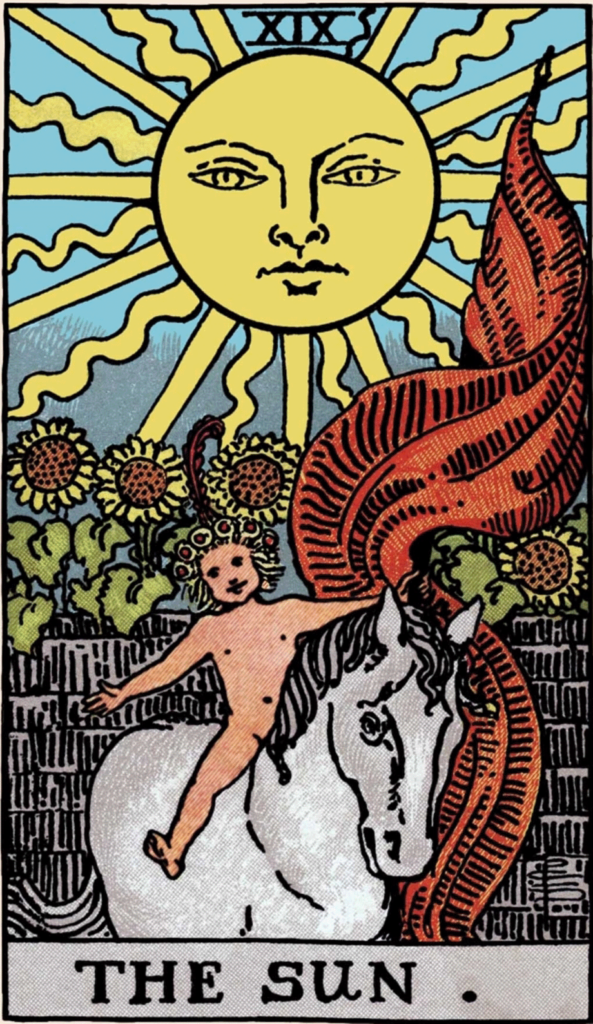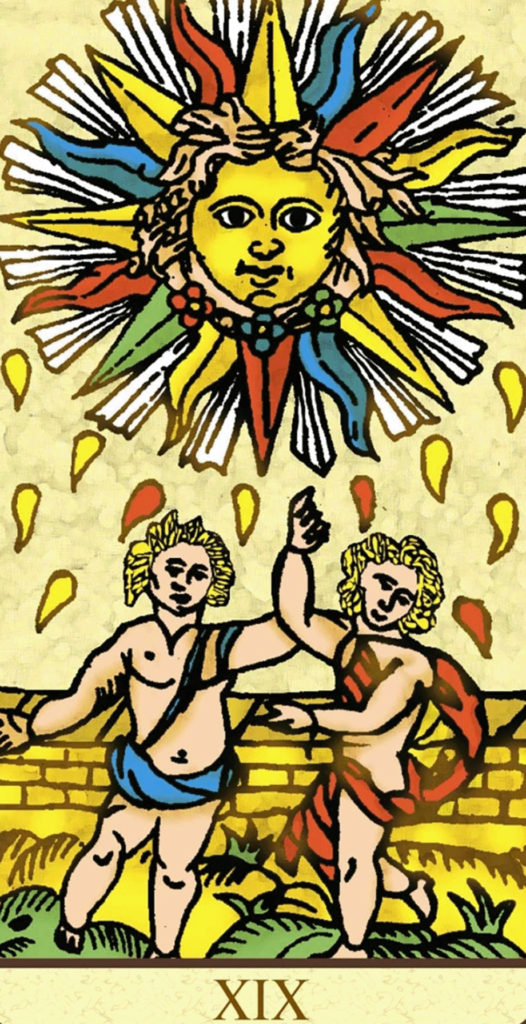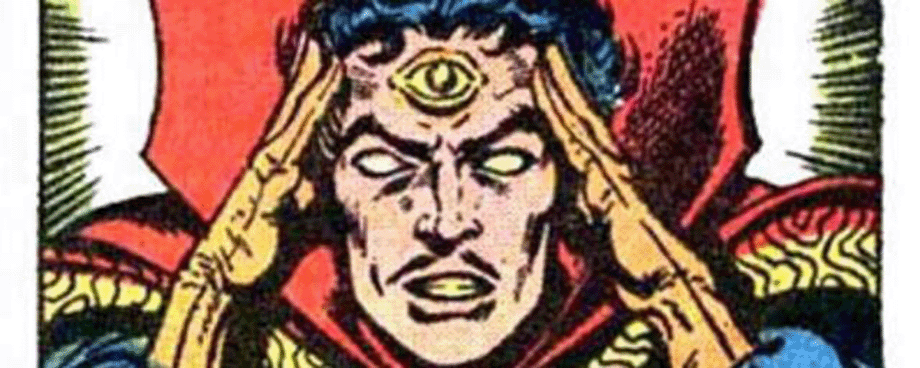All Hail the Coming of The Sun King!
Well, not me, thank you. I am a Creature of the Winter Dark, and the exultation of the primary luminary in his sign of Leo is not a comfort here in Texas with another week of 100°+ temps. The Sun is one of my least favorite cards. It’s certainly in the bottom five. I frequently avoid incarnations and avatars of the Sun in various mythologies. Save for it’s placement in my natal chart (only a couple of hours before dipping peacefully below the horizon) I do my best to avoid it. But here we are, and I shall try to assay it as best I can, though I shan’t say it will be without bias. No reading ever is.

Card XIX The Sun is characterized by a large solar disk, with 12 straight rays (assuming one behind the Roman numeral as logical) and 12 wavy rays. Beneath it in the background is a row of sunflowers planted behind a garden wall. In front of the wall there is a white horse. On his back is a nude child, crowned with a ring of smaller sunflowers and a red feather in the center. The child holds a great red banner.
The imagery here appears to be the more straightforward of almost any Tarot card. The rays can be taken to represent the hours of the day and the wavy rays those of the night (of which the Sun still holds sway). Alternatively, the rays can represent the signs of the Zodiac and the wavy rays the Houses, which are dependent upon the Rising Line. This meridian, most important in astrological calculations, is essentially the horizon at the time of birth. Since this is also a factor of the hour and moment, the Sun may be said to also control where the Houses are laid out. Equal Houses in a perfect system are synonymous with the signs, but because the Sun travels sign to sign over the space of about 30 days, and house to house in a period of twenty-four hours, there is likely to always be some variation. If a latitude driven House system like Placidus is used, then there is even more to take into consideration, but it is the Sun as arbiter of the hour that determines the Ascendant, and the Ascendant that determines the Houses. Since it is the Houses that are used to express good or ill omen of planetary placement and aspect, the Sun’s influence here may be as important, if not more important, than the Sun sign alone.
Sun signs are what most people who look at the daily horoscope are aware of. The Sun, as the biggest brightest and fastest moving object in our skies, has taken the lion’s share of the astrological celebrity. And lion’s share is appropriately given to him, as he is ruler of the Sign of Leo, that brightest and hottest season, following just after the Summer Solstice. The Moon, as his opposite, second largest, and second fastest, was given dominion over neighboring Cancer, preceding the Solstice, and expressed as water. Water as opposite the Sun’s fire makes a more complete analogy.
From these, then, the ancient Chaldees put the remaining five visible “wanderers” in charge of the chart in opposing pairs, starting with Mercury holding Gemini and Virgo, Venus with Taurus and Libra, Mars ruling the notorious Aries and Scorpio, Jupiter the burgeoning Pisces and Sagittarius, and finally old dark Saturn having sway over the cold winter signs of Capricorn and Aquarius. Comparatively recent discoveries of additional planets have necessitated given them rulership of signs in ways that seem most suitable, so the dark deep waters of Scorpio have been assigned to Pluto surrounded by his river Styx, Neptune rules the seas that Pisces swims in, and dreaming Uranus presides over Aquarian skies.
It is however the annual solar visit into each sign that gave us that popular Seventies singles scene question: “Hey, baby, what’s your sign?”. The Sun being biggest and brightest and fastest was given greatest influence in determining which characteristics would most mark an individual’s personality, or at least, their Leo-ness. The big and bold and egocentric and externalized aspects of ourselves are, like the bright Sun, and the charging Lion, what we see in ourselves and in others. The Moon, by contrast, governing the nightly tides, is equated to our tendency for emotional passions, thus our Moon Sign, is more frequently associated with our subconscious selves. Rounding out the top three is the Rising Sign, which is that sign where the Ascendant is placed, the sign on our “dawn” horizon at the hour of our birth. This is influential, in that it defines the First House, and the First House is the house of our ego, our self-image, and often our selfishness. Awareness of Sun, Moon, and Rising is becoming more common in the casual astrology follower these days, and are at least helpful if one doesn’t grasp the complex webs of planets, houses, aspects, rulerships, exaltations, detriments, falls, decans, parts, etc, that go into a full chart workup.
But what does all this astrology have to do with the Tarot card? Well, again, my approach to the Sun as a card is somewhat ambivalent. I think it’s a showy one-note card that just comes in bringing cheery good fortune and positive vibes and is very much often read like the Sun sign in a natal chart. That is, much more importance is given to its appearance than to the rest of the chart, or the rest of the Tarot spread itself.

The “arrival of Baby New Year” artwork smacks of the Baroque style of France’s Sun King Louis XIV. Now don’t get me wrong. I love Baroque art, but I am also conscious of the egotism involved. This is, after all, the man who, when told his plans for the palace at Versailles would bankrupt the state, replied “L’etat c’est moi.” – “I am the state.” While his great-great-great-grandson would lose it all (including his head) late, Louis XIV influence on the world and history was certainly worthy of the title he bestowed upon himself. Part of his propaganda was indulging a neo-pagan cult of Apollo, with him as the dutifully Catholic, but also fully mythical embodiment of the solar deity. The art and decoration of his palaces are resplendent with scenes of Greek myth, frequently erotic (and even pornographic) depictions of the Sun- centered sagas.
Which is why it’s curious to find that on the quintessential French Tarot decks, there are two children on this card. Most obviously when we find two of anything we expect an allusion to Gemini. Yet Gemini and the Sun are hardly related, as we’ve already expressed. The Sun rules Leo, little Mercury is charged with authority over Gemini. So who are these two, who often show up as cherubs in the iconography of other decks? There are perhaps a couple of candidates.
Let’s go with a French intrigue first. During the reign of the Sun King, a warrant was issued for one Eustache Dauger. Dauger was held in prison for the rest of his life, dying in the infamous Bastille. In this time he was the responsibility of a single jailer. This unusual arrangement has lead to much speculation, and expounded upon by the misreporting by the salacious minded Voltaire, that Dauger had been sentenced to wear an iron mask, forever obscuring his identity. It was also Voltaire who suggested that this person was an older bastard son of the previous king, and thus a longshot contender for the throne. Alexander Dumas, who penned The Man in the Iron Mask based on Dauger, makes him a moments older legitimate twin, whose existence must be kept secret by the usurper Louis. So perhaps these two children are a bit of naughty French parody that came at a later time (since during the reign of Louis XIV and indeed his successors, such a comment would send one to the Bastille or the guillotine.).
Another possible origin for the two children is an artistic theme quite common in Renaissance and later art associating the infant John the Baptist and the Christ Child. John, as the predecessor and prophet of Jesus, is a significant figure in the Gospels. John was an older cousin, according to the lore. When he was executed by Herod for preaching against him and the Roman occupation, Jesus moved up in prominence. It was fashionable in many works of religious art to show the two children together, often in the company of their mothers. Leonardo painted at least two such works, and the dual children on the Marseilles card always get me thinking of them.

The single child on the white horse is almost certainly a metaphor for the Christ, with his far too large red banner symbolizing the blood sacrifice that is reputed to save all of humanity. Confuting the Sun and the Son was useful in converting early pagans, and adopting some of the heliocal energies and attributions with the growing Christian cult. It’s important to remember that early Roman versions of Christ were not the bearded dark man we tend to view as Jesus today. Roman Jesus was Roman, often depicted as the Shepherd, clean-shaven, and light-haired or sometimes blonde. The infant in the Sun card is much more a remnant of that tradition, which is quasi-pagan, than of the later Gothic faith. This may be why I tend to bridle at the imagery of this card, which -at least artistically- doesn’t fit well with the style of the rest of the deck. I have no doubt that it was executed by Smith. Her definitive squiggle is buried down in the stones of the wall on the right. But it’s depiction is anachronistic in an otherwise congruous deck. It looks more like a Tiffany window than a Gothic icon. To me it just seems all too showy.
That is the nature of the Sun though. In hottest August, when all the summer’s growth has ripened and the true bounty of the earth has burst forth, we are perhaps able to appreciate this boisterous celebrant trump. If we are able to divorce it from the rather ham-handed Christian symbolism, and look at it rather as a pagan Sun that is part of the pagan celestial triad of Star-Moon-Sun, then it’s munificence and fertility might be felt as meant, and the traditional associations of fruition allowed to radiate out into the cards of the surrounding reading.
Two cards remain in the Major Arcana, styled XX-Judgement (sic) and XXI, The World. For many these last two complete the Tarot Journey begun with our ambling Fool about to walk off the cliff. Within them are the bones of their ancestors, and both artistically and oracularly they present a number of problems for the modern non-Christian reader. But I hope I am able to provide some incite into how I have worked around these shortcomings when using the traditional Rider-Waite-Smith deck.
As for this week’s trump, my best effort was to take it as astrologically as possible, because again, I just don’t like it.
We all have our favorites, and our non-favorites. We must be aware how that colors the story we tell to the client, or to ourselves, when either of those come up in the reading.
Until next week, thank you for your continued interest.




